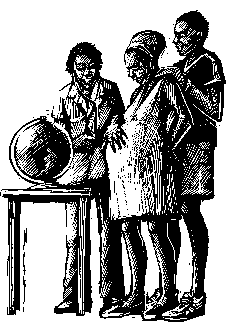|
|
|
|

Reproductive health; Providing access for all who need reproductive health services by 2015 as a development goal
by Richard Leete, Technical and Policy Division, United Nations Population Fund (UNFPA)

Reproductive health services are an area where gains have been made in recent years, but with rising numbers of people in poor countries passing through their reproductive ages, the pressure is on to sustain and build upon this progress in the decade ahead.
Increased attention is now being paid to the quality and range of services provided, including offering a wider choice of contraceptives, so as to meet the individual needs of women, men and adolescents.
Reproductive health services provide women, men and adolescents with the knowledge they need to protect their health and that of their families. The services include provision of family planning methods, prenatal and postnatal care, preventing and treating sexually transmitted diseases, including HIV/AIDS, and discouraging harmful practices against women, such as female genital mutilation. There is a growing recognition of the need to integrate such services into primary healthcare and to afford them priority when it comes to reform and decentralisation.
Take the example of the Islamic Republic of Iran, which in 1989 integrated a national family planning programme into its extensive primary healthcare system. This move not only led to increased access, but also helped to promote greater choice of contraceptive use. And in response to the 1994 Cairo International Conference on Population and Development (ICPD), the scope of the programme was widened to include other components of reproductive health. It proved to be a successful strategy. Between 1989 and 1997 the contraceptive prevalence rate per 1,000 married women aged 15-49 in Iran rose from 49% to 73%.
Measuring access to reproductive health services is anything but straightforward, since not only do questions like proximity to delivery points, the types of services available and their affordability have to be taken into account, but consideration also has to be given to the extent to which women feel free to utilise the available services.
Contraception is a case in point. Its use increased in all regions in the 1990s - but Africa lags markedly behind other regions, especially in the poorest African countries. Expanding the use of contraception clearly depends on access and information, but gender relations and power balances within couples are also important. Reproductive health depends on the extent to which men discipline their own sexual behaviour and support their partners' rights and health. Power relationships are often embedded in culture and customs, which is why education plays such a determining role.
Adolescent Problems
Another major challenge is to increase access to reproductive health information and services for adolescents. There are currently more than 1.1 billion adolescents aged 10-19, the largest number ever in this age group. Many adolescents lack formal education, work and beneficial recreation; many live in extreme poverty; and many are not sufficiently aware of the dangers they face, ill equipped to protect themselves and willing to take potentially life-threatening risks.
Globally more than 14 million adolescent girls give birth each year. A large proportion of those pregnancies are unwanted, and an estimated 4.4 million abortions are sought by adolescent girls each year.
Many adolescents also face serious risks of contracting sexually transmitted diseases, including HIV/AIDS. At the end of 1999, 33.6 million men, women and children were living with HIV/AIDS, 95% of them in developing countries. More than half of new HIV infections occur among 15-24-year-olds. Effective national programmes, together with massive international support, can help attack the pandemic at its root, offering hope to millions.
This is the thinking behind the ICPD plus 5 goal, which aims to ensure that by 2005 at least 90% of young men and women aged 15 to 24 will have access to the information, education and services they need to reduce their vulnerability to HIV infection. The aim is to cut the HIV infection rates in persons aged 15 to 24 globally, and by 25% in the most affected countries. Reducing levels of HIV/AIDS requires not only expanded access to quality reproductive health services, but also major changes in intimate aspects of human relationships and behaviour, in values and norms, and so on. That means education, via formal and informal programmes and media campaigns. But changes in behaviour also require support from political, religious and community leaders, who have to acknowledge the seriousness of the problem. Getting them to do so will be an important part of the challenge ahead. End
* The views in this article are those of the author and do not necessarily reflect those of UNFPA.
References
- United Nations, "Population and Development, Vol.1., Programme of Action Adopted at the International Conference on Population and Development". Cairo, 5-13 September 1994. United Nations, New York, 1995.
- United Nations, "Key actions for the further implementation of the Programme of Action of the International Conference on Population and Development." Report of the Ad Hoc Committee of the Whole of the Twenty-first Session of the General Assembly, New York 1999.
- United Nations Population Fund (UNFPA), Report of the 1998 UNFPA Field Inquiry: Progress in the Implementation of the ICPD Programme of Action, New York 1999.
- United Nations Population Fund (UNFPA). Country Population Assessment: Islamic Republic of Iran. UNFPA, Tehran, 2000.